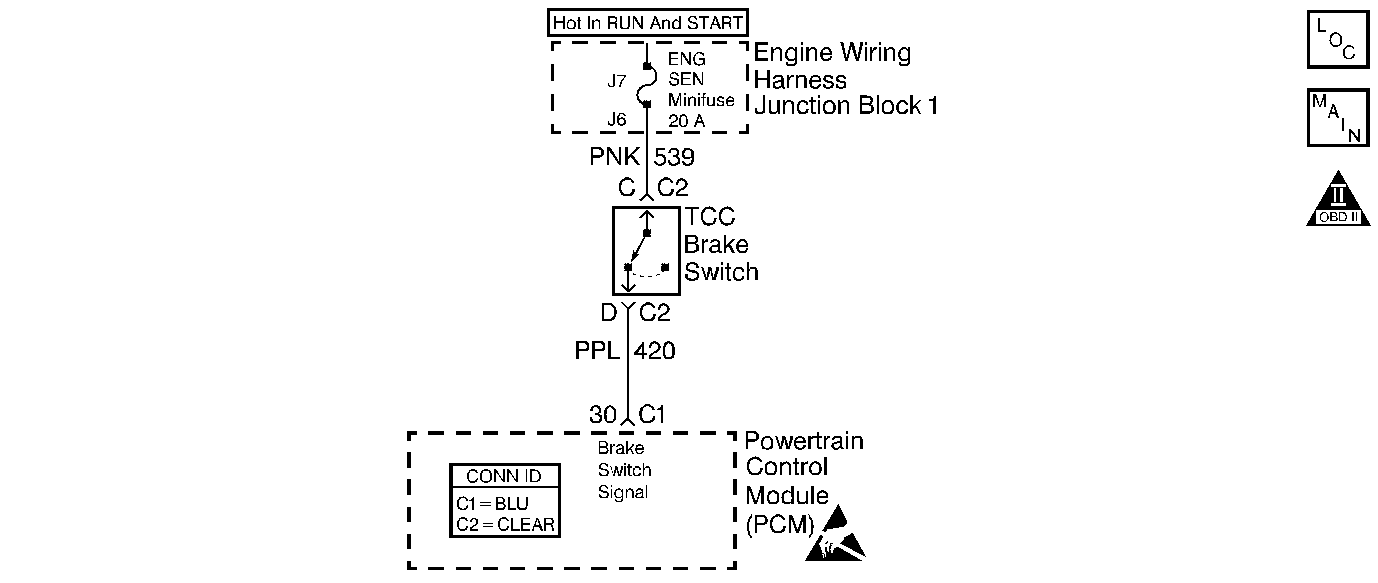
Circuit Description
The brake switch indicates brake pedal status to the powertrain control module (PCM). The brake switch is a normally-closed switch that supplies battery voltage to the PCM. Applying the brake pedal opens the switch, interrupting voltage to the PCM. This DTC is for manual transmission vehicles only, this switch is used for TCC operation on automatic transmission vehicles.
Conditions for Running the DTC
| • | The engine speed is more than 1000 RPM for 1 second. |
| • | The wheel speed is more than 20 mph in order to enable the diagnostic. The diagnostic disables when the wheel speed is less than 5 mph. |
Conditions for Setting the DTC
| • | The vehicle speed decreases 1 MPH in 0.5 seconds without the PCM sensing a switch transition. |
| • | The condition is present for 10 accel/decel cycles. |
Action Taken When the DTC Sets
The PCM stores conditions which were present when the DTC set as Failure Records only. This information will not be stored as Freeze Frame Records.
Conditions for Clearing the MIL/DTC
| • | The DTC becomes history when the conditions for setting the DTC are no longer present. |
| • | The history DTC clears after 40 malfunction free warm-up cycles. |
| • | The PCM receives a clear code command from the scan tool. |
Diagnostic Aids
Inspect for the following:
| • | Ask about the customers driving habits. Ask about unusual driving conditions (e.g. stop and go, expressway, etc.). |
| • | Inspect the brake switch for proper mounting and operation. |
| • | Inspect for ABS DTCs. A faulty ABS condition may contribute to setting this DTC. |
Many situations may lead to an intermittent condition. Perform each inspection or test as directed.
Important: : Remove any debris from the connector surfaces before servicing a component. Inspect the connector gaskets when diagnosing or replacing a component. Ensure that the gaskets are installed correctly. The gaskets prevent contaminate intrusion.
| • | Loose terminal connection |
| - | Use a corresponding mating terminal to test for proper tension. Refer to Testing for Intermittent Conditions and Poor Connections , and to Connector Repairs in Wiring Systems for diagnosis and repair. |
| - | Inspect the harness connectors for backed out terminals, improper mating, broken locks, improperly formed or damaged terminals, and faulty terminal to wire connection. Refer to Testing for Intermittent Conditions and Poor Connections , and to Connector Repairs in Wiring Systems for diagnosis and repair. |
| • | Damaged harness--Inspect the wiring harness for damage. If the harness inspection does not reveal a problem, observe the display on the scan tool while moving connectors and wiring harnesses related to the sensor. A change in the scan tool display may indicate the location of the fault. Refer to Wiring Repairs in Wiring Systems for diagnosis and repair. |
| • | Inspect the powertrain control module (PCM) and the engine grounds for clean and secure connections. Refer to Wiring Repairs in Wiring Systems for diagnosis and repair. |
If the condition is determined to be intermittent, reviewing the Snapshot or Freeze Frame/Failure Records may be useful in determining when the DTC or condition was identified.
Step | Action | Values | Yes | No |
|---|---|---|---|---|
1 | Did you perform the Powertrain On-Board Diagnostic (OBD) System Check? | -- | ||
2 | With a scan tool, observe the brake switch parameter. Does the scan tool indicate Released? | -- | ||
3 | Depress the brake pedal approximately half-way. Does the scan tool indicate brake switch as Applied? | -- | Go to Diagnostic Aids | |
4 | Test the adjustment of the brake switch. Refer to Stop Lamp Switch Adjustment in Hydraulic Brakes. Did you find and correct the condition? | -- | ||
5 | Inspect the condition of the fuse. Is the fuse open? | -- | ||
6 |
Does the test lamp illuminate? | -- | ||
7 |
Does the parameter switch to Released? | -- | ||
8 |
Does the parameter switch to Applied? | -- | ||
9 | Test the feed and signal circuits for a short to ground. Refer to Circuit Testing and Wiring Repairs in Wiring Systems. Did you find and correct the condition? | -- | ||
10 | Repair the open in the feed circuit. Refer to Wiring Repairs in Wiring Systems. Did you complete the repair? | -- | -- | |
11 | Test for an open in the signal circuit. Refer to Circuit Testing and Wiring Repairs in Wiring Systems. Did you find and correct the condition? | -- | ||
12 | Inspect for poor connections at the brake switch. Refer to Testing for Intermittent Conditions and Poor Connections and Connector Repairs in Wiring Systems. Did you find and correct the condition? | -- | ||
13 | Replace the brake switch. Refer to Stop Lamp Switch Replacement in Hydraulic Brakes. Did you complete the replacement? | -- | -- | |
14 | Repair the short to voltage in the signal circuit. Refer to Wiring Repairs in Wiring Systems. Did you complete the repair? | -- | ||
15 | Inspect for poor connections at the PCM. Refer to Testing for Intermittent Conditions and Poor Connections and Connector Repairs in Wiring Systems. Did you find and correct the condition? | -- | ||
16 |
Important: The replacement PCM must be programmed. Replace the PCM. Refer to Powertrain Control Module Replacement/Programming . Did you complete the replacement? | -- | -- | |
17 | With a scan tool, observe the brake switch parameter. Does the parameter indicate Released and switch to Applied when the brake pedal is depressed? | -- | System OK |
